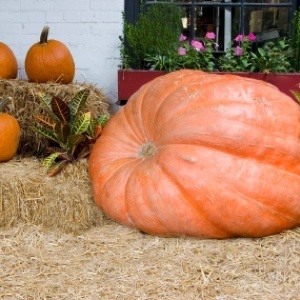 Growing giant pumpkins can be a fun and rewarding hobby for gardeners. And let's face it, a 500 pound Jack-o-lantern on Halloween is hard to ignore. Whether your goal is to make a statement with your fall display or win first prize at a local pumpkin weigh-off, once you've mastered some pumpkin growing basics, growing the giants isn't really that hard.
Growing giant pumpkins can be a fun and rewarding hobby for gardeners. And let's face it, a 500 pound Jack-o-lantern on Halloween is hard to ignore. Whether your goal is to make a statement with your fall display or win first prize at a local pumpkin weigh-off, once you've mastered some pumpkin growing basics, growing the giants isn't really that hard.
Lots of sunny space. Growing space is an important consideration when growing giant pumpkins, especially when you consider that the vines they grow on can reach lengths of 25 feet or more. When planning your pumpkin patch, choose a site that receives 8 hours of sun per day and allows you to space plants at least 15 to 20 feet apart.
Rich garden soil. Get your seedlings off to a good start by digging plenty of compost or well rotted manure into the beds the fall before you plant. Pumpkins prefer a soil pH of 6.5 to7.0. Start with a soil test and make amendments based on the results.
An early start. Giant pumpkins need approximately 120-130 days to reach maturity. To make sure they grow to their full potential, it's best to start plants early. Start them indoors in 6 inch peat pots approximately 4 weeks before your last frost date. Keep the soil warm (85-90 F) and look for seeds to germinate in 5-10 days. Harden-off seedlings and transplant them outdoors once their first true leaves appear, or when their roots start to grow through the sides of their pots.
Protection as transplants. Transplant shock can cause setbacks in growth. To minimize this, use row covers to protect transplanted seedlings from wind and unexpected frosts until the roots become established.
Plenty of food. Because of their giant size, it's tempting to overfeed them, but if pumpkins grow too big too fast the fruits may end up tearing from the vine before reaching their full potential. Always apply fertilizer based on your soil test results. Start out using a water-soluble fertilizer once a week and after pollination and fruit set occurs, switch to a foliar feeding program for the remainder of the growing season.
Plenty of water. Pumpkins need to receive a minimum of 1 inch of water per week-more during hot and dry conditions. Pumpkins have shallow roots so water slowly or use a drip irrigation system. Hand pollination. The earlier plants are pollinated and set fruit, the longer they will have to grow into their genetic potential. Hand-pollinate plants as soon as both male and female flowers appear. Pick a male blossom and move its pollen to a female flower. (Females have a small pumpkin at the base of their flowers.)
A good position on the vine. Once fruit sets and your pumpkins start to grow, gently reposition them so they are laying perpendicular to their vine (at right angles). If necessary, do this gradually over a period of several days to avoid injuring the vine. According to experienced growers, this is the optimal way to position giants for maximum growth.
Growing alone. During the initial growth stages, allow only 4 to 6 pumpkins to grow on each plant. Once they reach the size of small volleyballs, its time to reduce the competition even further. Select the best pumpkin on each plant and remove all the others. This will ensure that the one that remains will receive maximum nutrients from the vine.
You may not grow a record-breaking giant on your first try (that usually takes a bit of experience and a whole lot of luck), but producing a pumpkin in the 400-500 pound range is not out of the question if you start with the right seeds. If someday down the road you decide you want to enter a local weigh-off, you'll need to acquire pumpkin seeds from producers in the 800 lbs range and up.
The World's Largest Pumpkin
The world's largest pumpkin isn't just giant--it's gargantuan! The current record holder is Christy Harp's 1,725 pound Atlantic Giant pumpkin, which won the Ohio Valley Giant Pumpkin Grower's annual weigh-off in October 2009. So what is Christy's secret to growing great pumpkins? According to an article written about her in the New York Daily News, Christy credits genetically gifted seeds and a steady supply of compost, coffee grounds, and cow manure.
Here are the questions asked by community members. Read on to see the answers provided by the ThriftyFun community.
When growing pumpkins, is it necessary to remove female blooms to get larger pumpkins. How many fruits should be allowed to grow on one vine?
The more you pick off the blooms and just let one or two pumpkins grow per vine, the more the plant will focus on it getting the nutrients and growing bigger. Also, proper amounts of good compost & fertilizer.